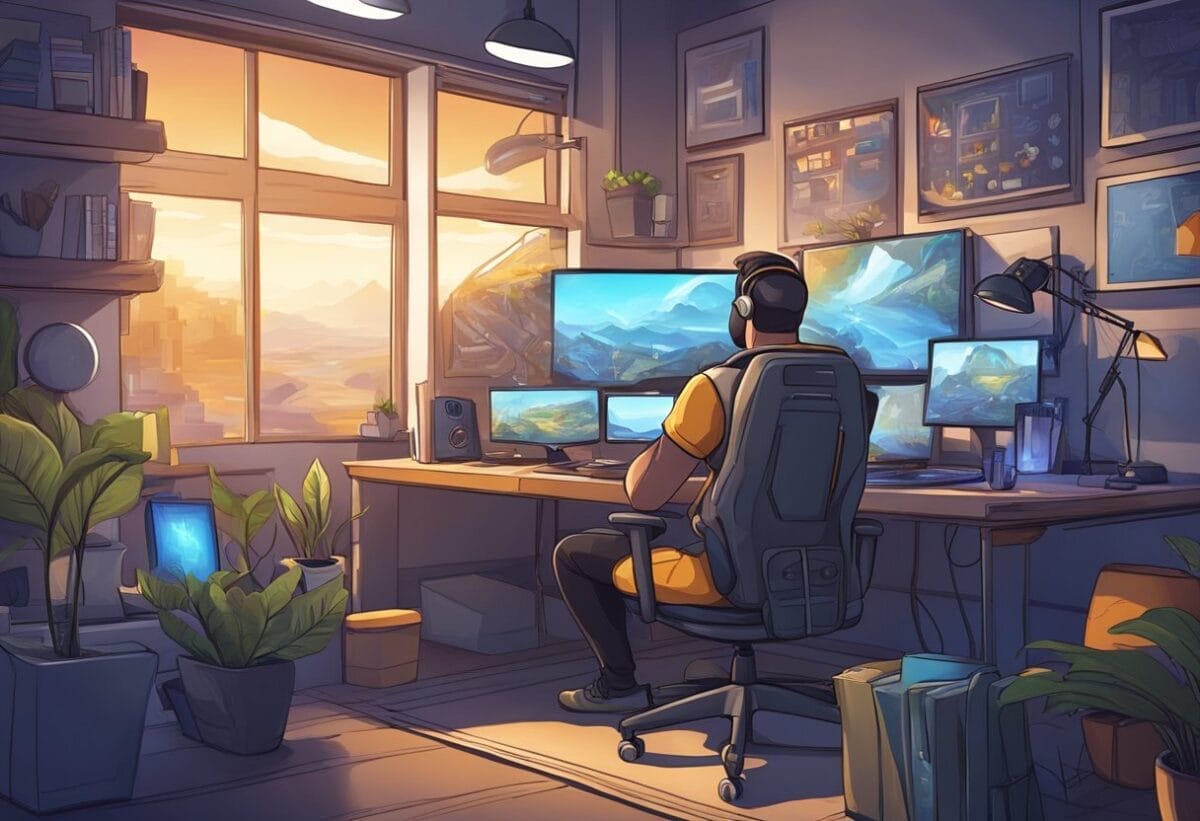Dreaming of becoming a game graphic designer, a game artist in the gaming industry?
As a game graphic designer, you’ll shape the visuals of games, bringing stories and characters to life. This role blends art and technology, and it’s crucial to stay updated on current trends. Knowing where the industry is headed can help you make strategic career moves.
To get started, you need passion, creativity, and the right skills.
KEY TAKEAWAYS
- Passion, creativity, and skills are essential to becoming a game graphic designer.
- Stay updated on industry trends to make informed career choices.
- Master key skills and secure your first job.
What is a Game Graphic Designer?
A game designer, particularly a game graphic designer, creates the visual elements and interfaces in video games. You need to have strong design skills, a keen eye for detail, and a passion for gaming.
Key Responsibilities of a Game Graphic Designer
As a game graphic designer, your main job is to:
- Design the visual aspects of a game; this includes characters, environments, and user interfaces.
- Collaborate with other designers, artists, and developers to bring a game to life.
- Work on creating concept art and storyboards; this helps in visualizing the game before actual development starts.
- Ensure that the visual style is consistent throughout the game.
- Understand some coding basics to make sure graphics integrate well with the game engine.
Your ability to create visually appealing and functional designs plays a huge role in the success of the game.

Educational Requirements and Qualifications
To become a game graphic designer, you typically need a degree in graphic design, game design, or a related field. Courses in fine arts and computer science are also beneficial.
Other form of requirements and “go-to-have” includes;
- Portfolio to showcasing your previous work; this is your chance to show potential employers your skills and creativity.
- Internships and freelance work to provide valuable experience and networking opportunities.
- Skills in software tools such as Adobe Creative Suite and various 3D modeling programs.
Many resources are available to help you stay ahead in this competitive field.
- Keeping your skills updated with the latest trends and software in the video game industry is crucial for career growth.
- Completing online courses and certifications can also enhance your qualifications.
Salary of a Game Designer

The salary of a game designer can vary significantly based on several factors. These include experience, education, skills, and location.
A Game Designer earns an average of $82,098 annually. The typical range is between $74,358 and $92,182. Additional bonuses and incentives might increase the total compensation to around $85,394.
| Category | Low | High | Average |
|---|---|---|---|
| Base Salary | $74,358 | $92,182 | $82,098 |
| Total Compensation | $76,575 | $96,638 | $85,394 |
Different cities offer different salaries. For instance, Arlington, MA, offers higher salaries compared to smaller cities.
Influential Factors:
- Experience: More experience often leads to higher pay.
- Education: Degrees in Game Design, Computer Science, or related fields can influence salary.
- Certifications and Skills: Specialized skills and certifications can also lead to better compensation.
For those considering a career in game design, understanding these factors can help you plan your path more effectively.
Current Trends and Outlook of Game Designer

Game design is constantly evolving.
You must stay updated on current trends. This helps you stay competitive and relevant.
Important Current Trends
- Virtual Reality (VR) and Augmented Reality (AR): Many game designers are focusing on immersive experiences using VR and AR technologies.
- Mobile Gaming: Game design for mobile platforms is booming. Mobile games are a huge part of the market.
- Cross-Platform Play: Designing games that can be played on multiple platforms is crucial.
- Indie Game Development: Independent game development is growing, giving more creative freedom to designers.
- Game Streaming Services: With the rise of platforms like Stadia and Xbox Cloud Gaming, streaming services are transforming the industry.
Job Outlook
The job outlook for game designers is promising. The demand for skilled designers is strong. This trend is expected to continue as the gaming industry grows.
Skills in Demand
Acquiring the necessary graphic designer skills is key.
- Technical Skills: Proficiency in game design software and programming.
- Creative Skills: Ability to create engaging and innovative game concepts.
- Problem-Solving Skills: Addressing design challenges effectively.
Unique Perspectives
Each game designer brings a unique perspective. This diversity in thinking is vital for innovation in game design. As you gain experience, your unique outlook will be your greatest asset.
Resources
For more insights, you might explore “Becoming a digital designer” or “The Gamer’s Brain” for more depth on trends and design.
How to Become a Game Graphic Designer?
Becoming a game graphic designer is the dream job for most gamers who loves creating their unique style and visual to enhance the visual impact of a game.
Here are some steps you’ll need to take to become a game graphic designer.
Step 1: Getting Started to Becoming a Game Designer

Starting your journey to become a game designer requires knowing your educational and training options. You can follow different paths such as formal education, self-taught learning, and game design bootcamps to learn video game design skills.
Formal Education vs. Self-Taught Learning
Choosing between formal education and self-taught learning depends on your learning style and resources.
- Formal education, like a bachelor’s degree in video game design, offers structured coursework and access to professional instructors. It also provides networking opportunities and hands-on projects.
- Self-taught learning, on the other hand, offers flexibility. You can use online platforms, tutorials, and resources to learn at your own pace. This path requires discipline and motivation but can be more affordable. Game designers who are self-taught often build portfolios and work on freelance projects to gain experience.
Relevant Degree Programs
Enrolling in a relevant degree program can be an important step. Bachelor’s degrees in game design, computer science, or graphic design are common choices. These programs cover subjects like programming, animation, and storytelling.
Many universities offer specialized degrees in game development. These degrees will teach you;
- Learn how to create video games
- Gain understanding of game mechanics.
Relevant degree programs provide a comprehensive education that combines both theory and practical skills, preparing you for a career path as a video game designer.
Game Design and Development Bootcamps
Game design bootcamps offer intensive, short-term training. These programs are ideal for those looking to gain skills quickly. Bootcamps focus on hands-on learning with projects that mirror real-world game development.
They typically last a few months and can be a good alternative if you don’t have the time or resources for a four-year degree.
- Cover specific areas like game mechanics, coding, and graphics.
- Provide opportunities for collaboration and networking with other aspiring game designers.
Starting with a bootcamp can be a practical step if you want to dive into video game development right away. This route can help you build a portfolio and connect with industry professionals.
Step 2: Acquiring Key Skill Set For a Game Graphic Designer

To become a game graphic designer, you need a mix of artistic and technical skills.
Artistic Skills
- Drawing and Illustration: Basic to advanced drawing skills help you create and communicate visual ideas.
- 2D and 3D Art: Understanding 2D tools like Adobe Photoshop and 3D software like Blender or Maya is crucial.
- UI/UX Design: Focus on user interface and user experience to make your designs user-friendly and engaging.
Technical Skills
- Game Engines: Familiarity with game engines like Unreal Engine or Unity is essential. These tools help bring your designs to life.
- Scripting Languages: Learning scripting languages such as Python, Lua, or C# can help you with technical implementation.
Soft Skills
- Communication: You will need strong communication skills to work with a team effectively.
- Problem-Solving: Game design requires creative solutions to complex problems.
- Adaptability: Being adaptable and willing to learn new tools and techniques will keep you relevant in the industry.
Practical Experience
Creating sample projects or participating in game jams can provide hands-on experience. Building a portfolio showcasing your skills will impress potential employers.
Focus on learning and improving these skills to pave your way to a successful career in game graphic design.
Step 3: Landing Your First Game Graphic Designer Position

Landing your first job as a game graphic designer involves smart job search strategies, crafting a standout resume and cover letter, and excelling during interviews.
Job Search Strategies
There are many ways you can get a job as a game graphic designer, both traditional and out-of-the-box strategies;
- Start by exploring job boards dedicated to the gaming industry; websites like Gamasutra and ArtStation frequently post openings for game designers.
- Networking is key; Attend gaming conventions and online webinars to meet industry professionals.
- Be active on LinkedIn and other social media; Reach out to recruiters who specialize in gaming roles.
- Share your portfolio; Engage with posts related to game design.
Using these strategies can help you get into the game industry more effectively.
Creating an Impressive Resume and Cover Letter
Your resume should highlight your technical skills and creative achievements.
- List your experience with software like Adobe Creative Suite, Maya, and Unity.
- Demonstrate your understanding of the game development process.
- Use bullet points to outline specific projects and your role in them.
Your cover letter should be concise and to the point. Mention your passion for video game design and refer to any relevant projects you’ve completed.
Always customize your cover letter for each application to show genuine interest.
Preparing for Interviews
Before your interview, research the company and understand the games they create.
- Prepare to discuss your portfolio in detail, explaining your design choices and the creative process behind them.
- Practice common interview questions, such as your experience with design software and how you handle creative criticism.
- Use examples to demonstrate your ability to work well in a team is crucial since game designers work closely with other developers.
Staying calm and confident during your interview will help you stand out and improve your chances of landing the job.
Focus on showing your enthusiasm for the industry and your ability to contribute to their projects.
Step 4: Nurturing a Successful Career in Game Graphic Design

Building a career in game graphic design involves constant learning, networking, and understanding market trends. These three elements help you stay relevant and excel in the ever-evolving game design industry.
Continuing Education and Skill Advancement
To succeed in game graphic design, you need to keep updating your skills. Take online courses and attend workshops. Many video game designers start with degrees, but education should continue. Learning new software, techniques, and game design principles is crucial.
- Consider enrolling in courses about game programming and 3D modeling.
- Start learning from successful game designers.
Use latest tools like Blender, Unity, or Unreal Engine to stay current. Education isn’t a one-time event but a continuous journey.
Networking in the Video Game Industry
Networking can open doors to job opportunities and collaborations.
- Attend industry events like game developer conferences.
- Join online communities and forums where game programmers and designers gather.
- Connect with other professionals through platforms like LinkedIn.
Building relationships with other game designers and programmers can offer insights and job leads. Join local gaming meetups to stay connected with your community.
Networking also helps you understand what game designers need to keep in mind when developing new projects. Sharing your portfolio and getting feedback can be invaluable.
Understanding Market Trends and Player Demands
Successful game designers develop games that players want. To make video games that resonate, you need to stay informed about market trends.
- Follow gaming news sites and industry reports.
- Understanding what players are looking for can guide your design decisions.
- Survey players and read game reviews to get insights.
Doing these can help you create games that meet player demands and stand out in the market.
Following trends allows you to bring fresh ideas to your projects. Adapting to what’s popular ensures your designs are relevant and engaging.
Nurturing your career involves consistent learning, effective networking, and understanding player and market demands. These steps help you stay ahead in the game industry.
Step 5: Exploring Advanced Opportunities and Specializations

In this step, you will explore senior roles, leadership responsibilities, and creativity in game graphic design. Deepening your skills in these areas can elevate your career and open new doors.
Senior Designer Roles and Lead Positions
Advancing to senior designer roles involves gaining extensive experience and mastering your craft. Senior designers often lead projects and teams, making critical decisions on game design elements and direction. These roles require understanding intricate details of game aesthetics and mechanics.
Lead positions demand excellent communication.
- You must articulate your vision to diverse teams, including programmers, artists, and video producers.
- You will be involved in mentorship, helping junior designers grow and thrive.
Transitioning from designer to leader means taking on greater responsibilities and influencing the creative process significantly.
Cross-Disciplinary Collaboration and Team Leadership
Effective game design requires collaboration across disciplines. You need to work closely with game programmers, artists, sound engineers, and writers. Building solid relationships with these team members ensures a cohesive and engaging game experience. Communication skills are crucial here.
- Team leadership in game graphic design is about coordination and inspiration.
- You will encourage creativity while ensuring the vision and goals of the game are met.
- You need to balance artistic freedom with project constraints, like budgets or timelines, fostering a collaborative spirit that drives innovation.
Innovation and Creativity in Game Graphic Design
To stand out in the gaming industry, embracing innovation and creativity is essential. This involves;
- Staying up-to-date with the latest design trends and technology.
- Experiment with new tools and techniques to create visually striking game elements.
- Pushing the boundaries of what’s possible can lead to groundbreaking designs.
Thinking outside the box can help bring new dimensions to game design. Whether it’s introducing unique character designs or creating immersive environments, your creativity can set the tone for the entire game.
By excelling in these areas, you will position yourself as a leader in game graphic design, capable of tackling complex challenges and driving the future of the industry.
Get your 100% Free online resume and get noticed by potential employers. Start out of the crowded space of millions of remote job seekers and find the remote job that you will enjoy and love.

Join over 11,000+ achievers who are committed to achieving their career goals!

![How to Write Cover Letter for Resume [Complete Guide] 10 How to Write Cover Letter for Resume [Complete Guide]](https://hqhire.com/wp-content/uploads/2020/11/Cover-Letter-for-Resume-1-768x402.png)




